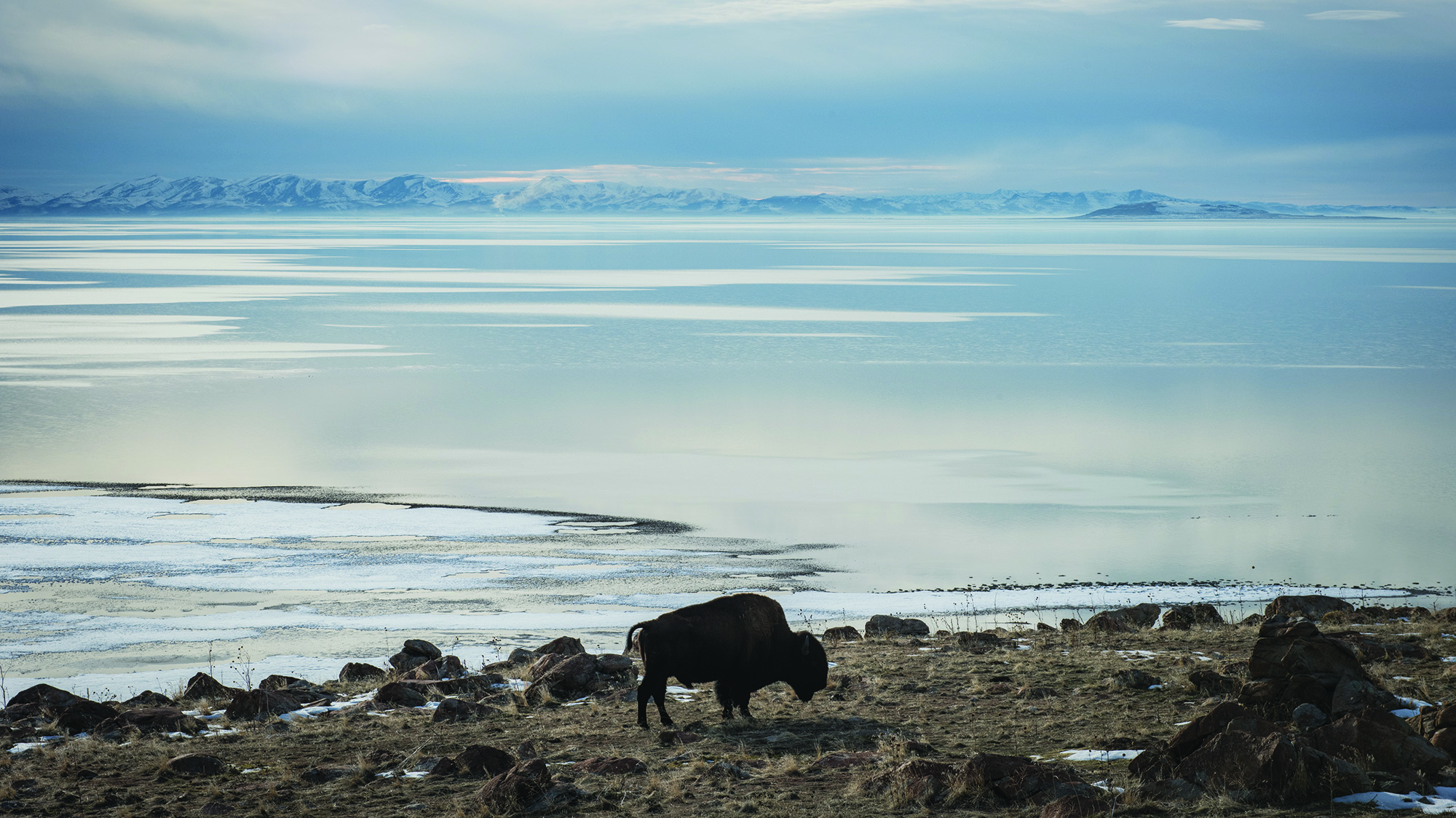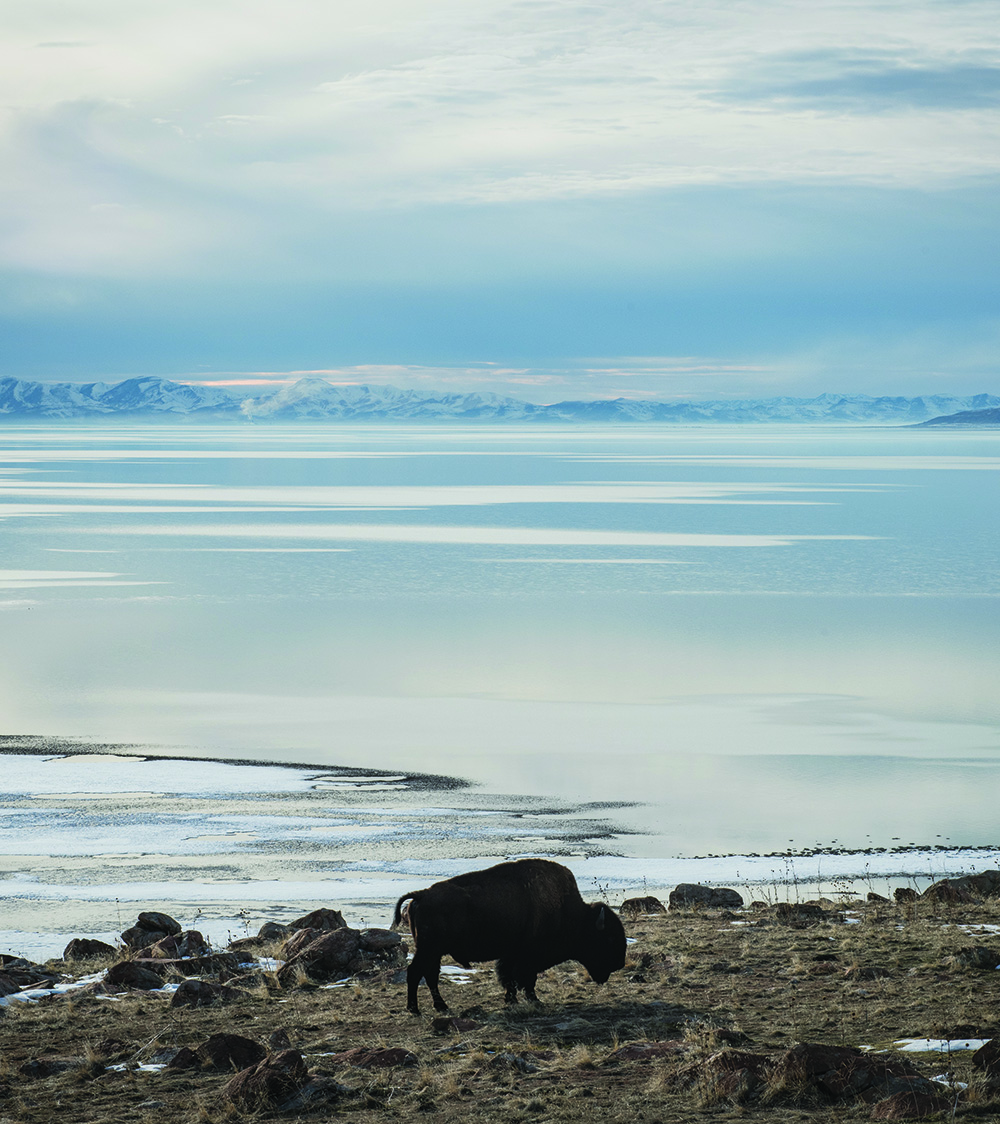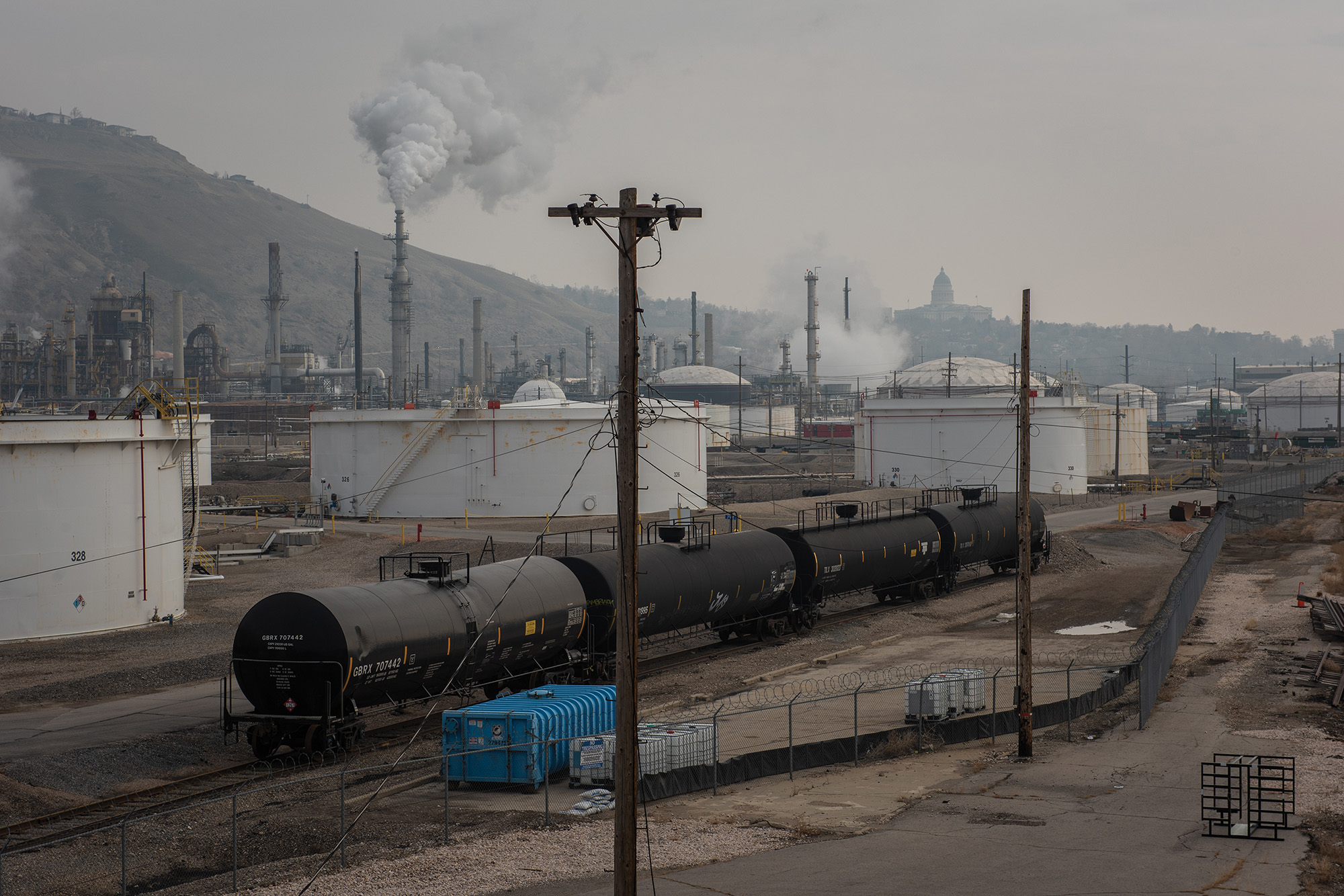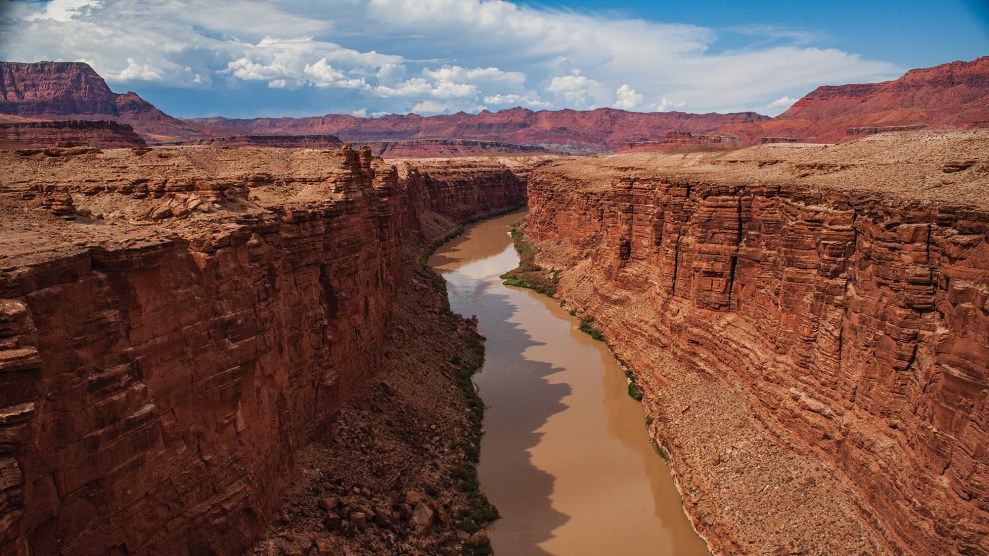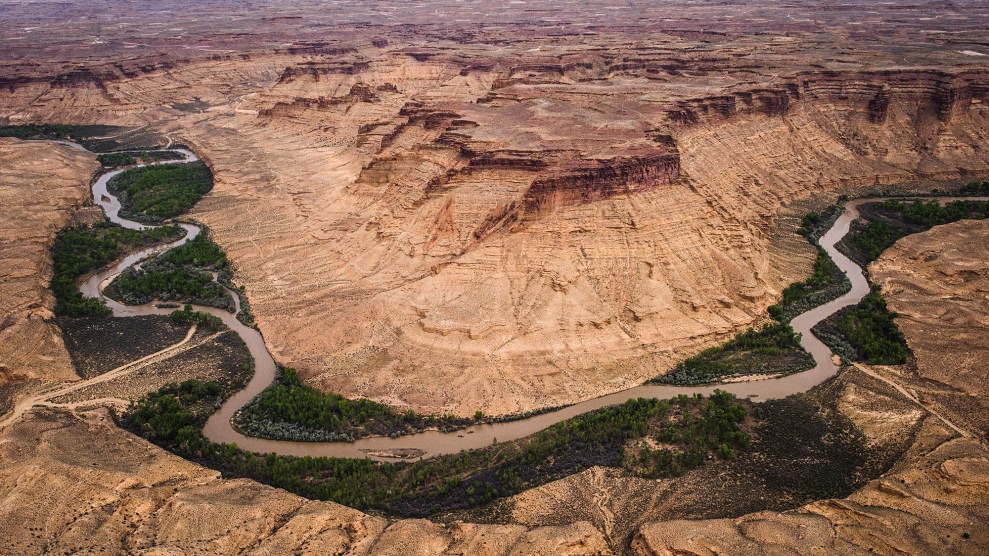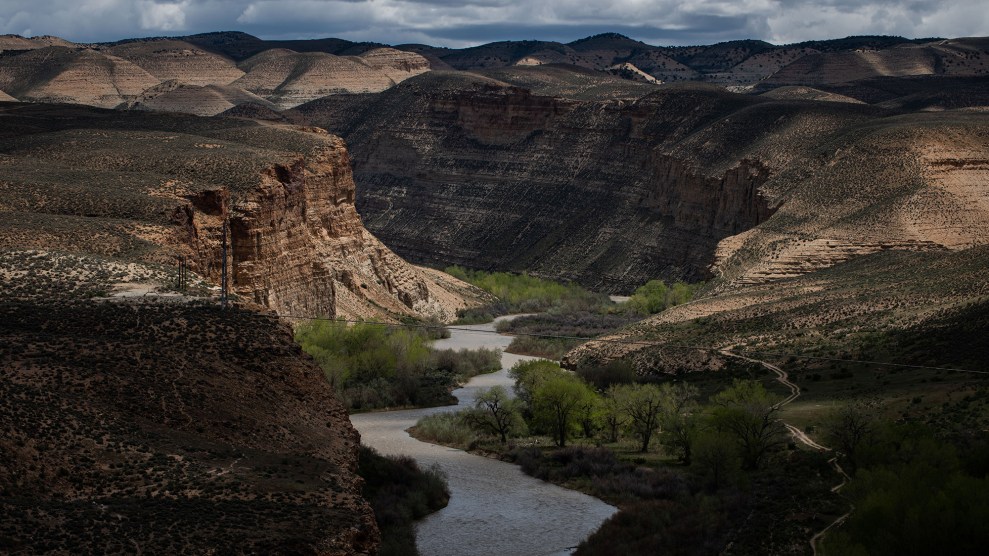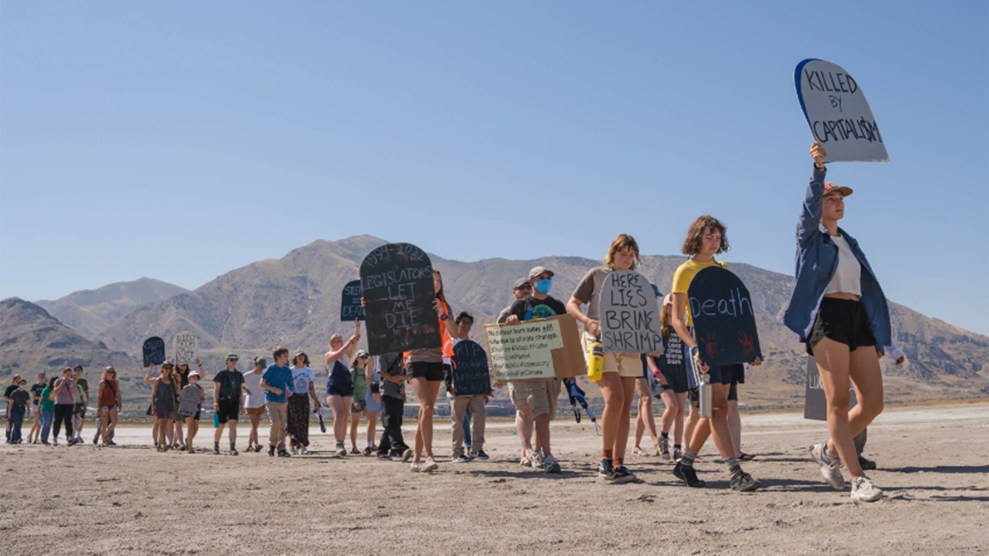Water is life. It’s also big business. In our November + December 2023 issue, Mother Jones dives into the West’s deepening water crisis—and the forces behind it, from historic drought to short-sighted policies to corrupt lawmakers and the special interests they serve. Read the full package here.
In October 2021, an increasingly dire megadrought had left Utah’s most famous lake at its lowest level in recorded history. As Great Salt Lake lay dying, Democrats introduced a modest water conservation bill requiring efficient plumbing fixtures in all new construction, a provision that many states in the West already have. In a state known for wasting enormous amounts of municipal water, it would have saved enough water to supply 30,000 homes annually by 2030. The bill should have been an easy sell.
Instead, some rural lawmakers were opposed because they believed that if people flushed less water down their toilets, Great Salt Lake would dry up faster. “I have concerns about the government telling me what kind of toilet I can have in my house,” said Republican state Rep. Casey Snider, a farmer from Cache County. “I’m concerned what it can do to the Great Salt Lake.” The bill never made it out of committee.
Great Salt Lake is the largest saline lake in the Western Hemisphere, and an all-important stop for millions of birds traveling along the eastern spur of the Pacific Flyway from as far south as Chile and as far north as the Arctic Circle. It’s also the country’s largest source of magnesium, a critical element in metal production. And as a terminal lake—none of it flows out to other rivers or the Pacific Ocean—it creates a unique hydrologic cycle along the Wasatch Front. This “lake effect” is responsible for Utah’s other famous product: the powdery snow that draws millions of skiers from around the globe and contributes more than $2 billion to the state’s annual economy. That snow, in turn, makes northern Utah semiarid and thus more livable than neighboring desert states like Arizona and Nevada.
But in January 2023, scientists at Brigham Young University, a Mormon institution, issued a report containing a dire warning: “The lake as we know it is on track to disappear in five years.” Since 1850, it has lost more than 70 percent of its water and 60 percent of its surface area, mostly because people are sucking it dry. Rising global temperatures and extensive drought are accelerating the decline, creating a public-health and ecological disaster.
As the lake dries up, sediment full of arsenic and other toxins takes flight, contributing to air pollution in Salt Lake City, which already has some of the worst air quality in the world, thanks to emissions from cars, oil refineries, and one of the planet’s largest open-pit copper mines. Owens Lake in California, another saline lake that was drained to supply Los Angeles, ended up becoming a Superfund site and one of the largest sources of dust pollution in the United States. Great Salt Lake is more than 10 times bigger than Owens Lake was.
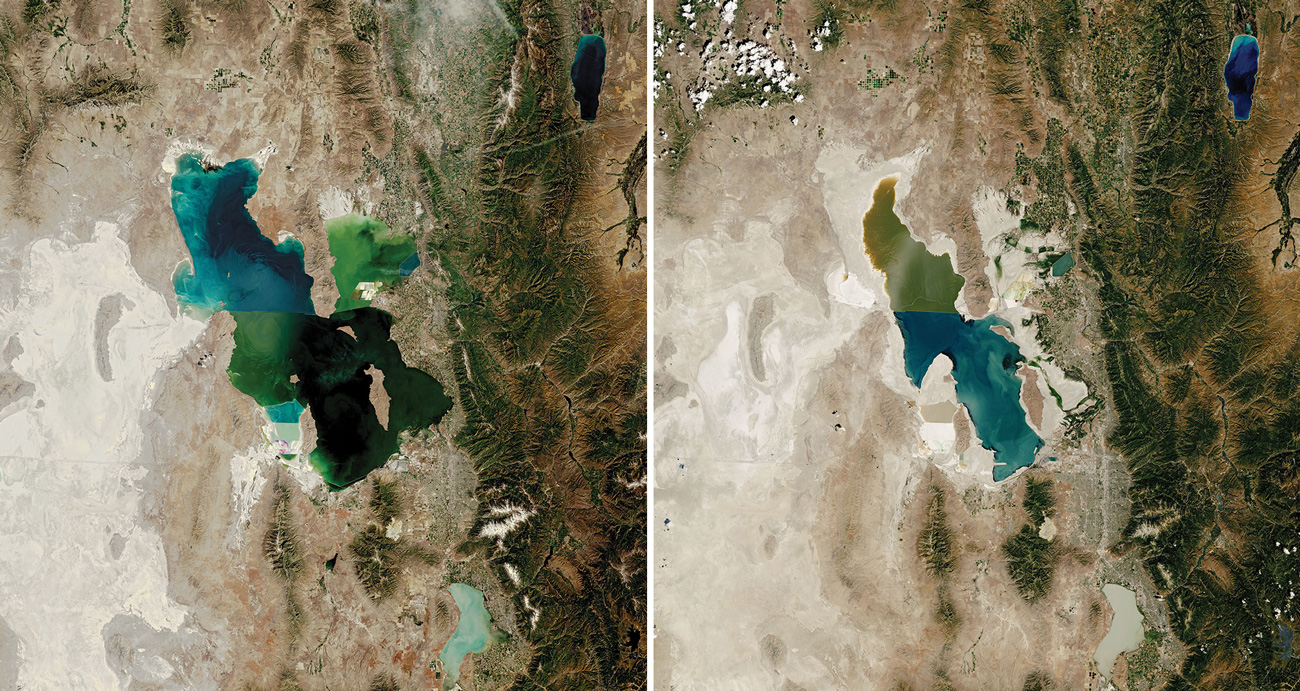
The Great Salt Lake in June 1985 (left) and July 2022.
NASA
While Great Salt Lake has global significance, it is the government of Utah—one of the most gerrymandered states in the West—that is primarily responsible for its management. In 2020, Joe Biden won Salt Lake County, the state’s most populous, by more than 10 points. Statewide, he won nearly 40 percent of the vote. Yet in the legislature, which is more male, white, and Mormon than the rest of the state, Republicans have a veto-proof supermajority, controlling about 80 percent of the seats. If anyone is going to rescue Great Salt Lake, it will have to be conservative Republicans, whose historic opposition to water conservation doesn’t instill a lot of faith.
The Great Salt Lake crisis is “not a water problem,” explains Ben Abbott, a BYU professor of ecology who was a lead author of the report sounding the alarm about the lake. “It’s a governance problem.”
Over the past two years, the farmers, real estate developers, and others who make up Utah’s part-time legislature have proposed a range of solutions: clearcutting forests, building a pipeline to the Pacific Ocean, even cloud seeding—the dubious process of shooting silver iodide into the air to create more snow. “Dozens of boondoggles have been proposed for Great Salt Lake,” Abbott says. “But the only thing that will get water to Great Salt Lake is conservation.”
Recently, as residents have started to demand a response to the crisis, Utah politicians claim to have directed nearly $1 billion to restoring the lake. But much of that funding paid for water projects that had nothing to do with conservation or Great Salt Lake. Even after a record snowmelt in 2023, the lake elevation is projected to end the year at least 9 feet lower than it needs to be healthy. “Utah legislators have really failed to implement meaningful policies to put water in the lake,” says Zachary Frankel, executive director of the environmental nonprofit Utah Rivers Council, which joined others in filing suit against the state in September for failing to do more. “They’ve celebrated and patted themselves on the back for baby steps while they should be taking leaps.”
On a bracingly clear day in June 2020, I stood next to the Temple Fork River, watching water babble over beaver dams while a breeze rustled the aspen trees high up on the hillside of Logan Canyon. The area is home to the Bonneville cutthroat trout, the Utah state fish that was thought to be nearly extinct 40 years ago, and that conservation groups have spent decades trying to protect.
In two decades, the spot where I stood could be more than 200 feet underwater, part of a reservoir designed to hold more than the equivalent of 20,000 Olympic swimming pools. The Temple Fork dam is one of up to six planned for the watershed of Bear River, Great Salt Lake’s biggest tributary. The project would divert 220,000 acre-feet of water for municipal use along the sprawling Wasatch Front—depriving Great Salt Lake of so much inflow that it would drop by at least 5 feet. You might think that with the lake facing imminent catastrophic collapse, an absurd project such as this would have been abandoned. But this is Utah, so you would be wrong.
Scientists have been warning for years that Great Salt Lake is at risk of vanishing. Yet in 2016, the state legislature passed a bill to dedicate one-sixteenth of a cent of state sales tax to funding the Bear River project and another one of Utah’s zombie boondoggles, a proposed pipeline from the dying Lake Powell on the Colorado River to feed the lawns of the growing sprawl of southern Utah.
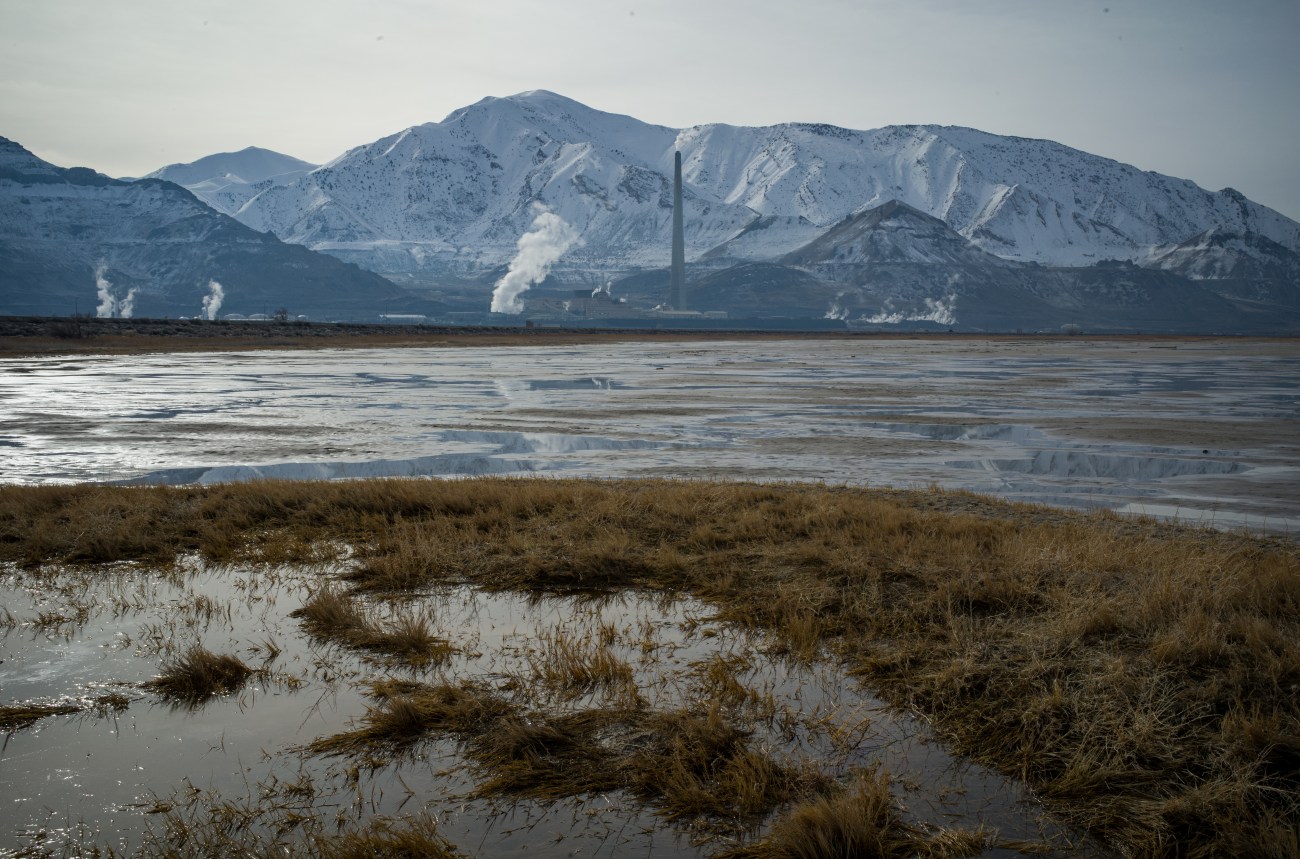
Shrinking shorelines on the Great Salt Lake
The fund has since accumulated more than $150 million, and promoters reportedly hope to complete the permitting process for the Bear River project by 2030. Given that most of Great Salt Lake could be dried up by then, Democratic Rep. Joel Briscoe introduced a bill in this year’s legislative session that would direct $60 million annually of that money toward restoring the lake instead. Once more, the bill never got out of committee.
Water development has long been a focus for Mormons in Utah. Their pioneering irrigation systems made much of the Western population growth possible. “Without realizing it, they were laying the foundation of the most ambitious desert civilization the world has seen,” wrote Marc Reisner in his classic 1986 book, Cadillac Desert. “[T]he Mormons attacked the desert full-bore, flooded it, subverted its dreadful indifference—moralized it—until they had made a Mesopotamia in America.” When the US government launched its own irrigation and dam building program in the West in 1902, he noted, it was “based on Mormon experience, guided by Mormon laws, run largely by Mormons.”
That love of massive water projects persists among Utah’s political leadership. In 2022, then-Utah House Speaker Brad Wilson convened a summit on Great Salt Lake where Sen. Mike Lee (R-Utah) spoke about what the federal government might do to help avert the impending catastrophe. Lee’s solution? More dams, which, of course, would prevent water from reaching the lake. Lee complained that federal environmental laws prevented the state from building new water storage infrastructure as quickly as it did in the early part of the 20th century. He suggested a return to those days was “exactly the sort of thing we need.”
Conservation is not a strong suit of people who for 175 years have viewed water as something to be used, not saved. “We should waste nothing,” taught the prophet Brigham Young, “but make everything in some way or other minister to our wants and independence.” Young led persecuted Mormon settlers to the Salt Lake valley in 1847. They quickly built irrigation canals not just for survival but also to fulfill the biblical prophecy of Isaiah: “The desert shall rejoice, and blossom as the rose.”
The collective irrigation companies that Mormon pioneers created to make the desert bloom have evolved into powerful special interests, which are today’s water districts. Derisively called “water buffaloes” by environmentalists, these water districts are served by lobbyists who have killed off conservation bills for years, while pushing for multibillion-dollar dam and pipeline projects, such as the one on Bear River, to benefit water companies, construction and engineering firms, and land developers. That’s one reason why convincing Utah Republican officials to focus on conservation has been so hard. There’s no money in persuading people to tear out their lawns.
And yet, BYU’s Abbott says Utah isn’t the outlier it might seem; there are more than 100 terminal, saline lakes like Great Salt Lake around the world, and all of them are dying. “Nobody’s figured out how to do this,” he told me.
The entrance to Antelope Island State Park welcomed my then-14-year-old daughter and me with a sign announcing that the biting gnats have hatched. “No refunds due to insects,” it warned. I grew up 25 miles from here but can’t remember ever visiting. This may have been why.
It was a clear, midsummer day in 2020. Great Salt Lake stretched out for miles before us as we drove past grazing bison to the visitor center. We perused exhibits about the ancient lake that once covered this entire valley, and checked out a tank of brine shrimp for a close-up view of one of the few aquatic life-forms that can survive in the hypersaline lake. The shrimp, better known as “sea monkeys” that kids once ordered from the back of comic books, are harvested here and sold as food for farmed fish, a $60 million industry.
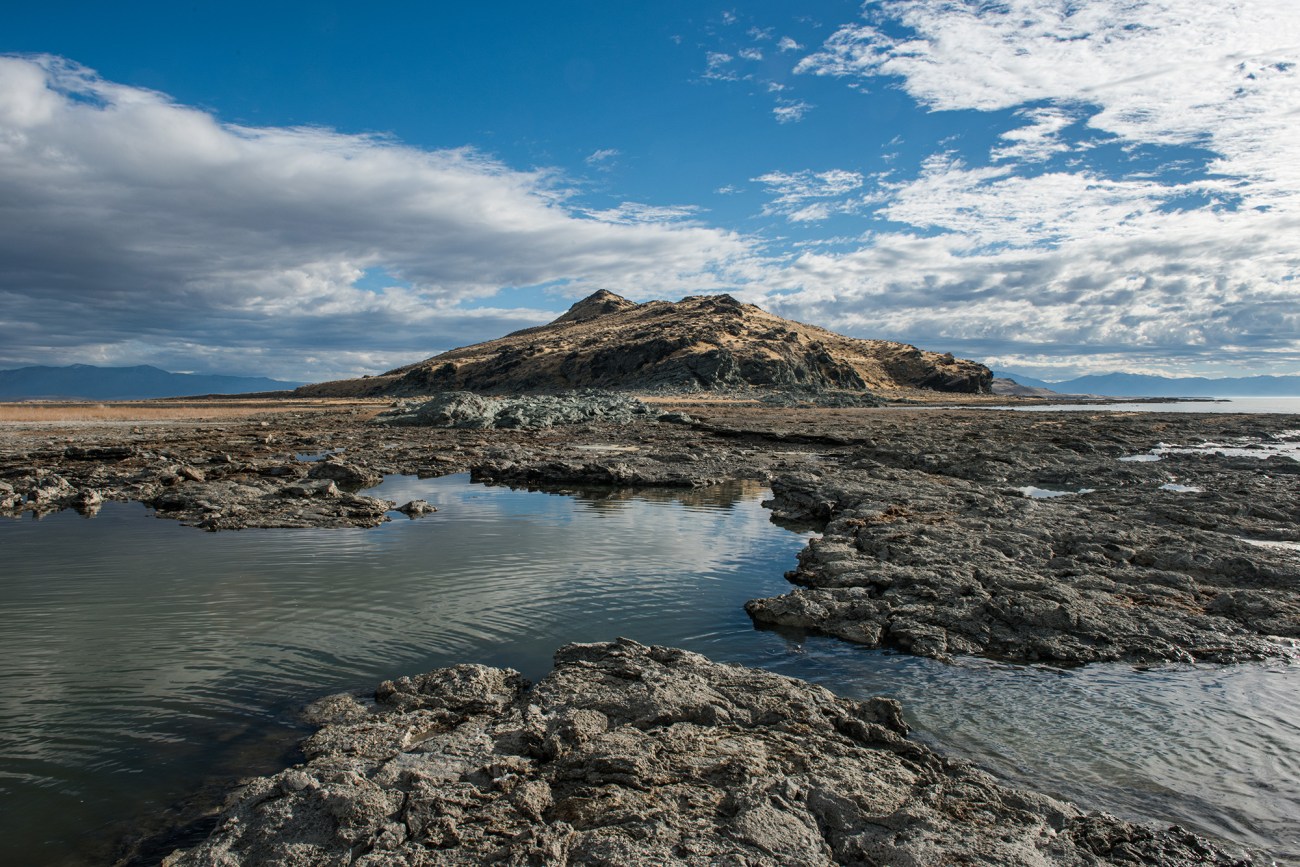
Fremont Island on the Great Salt Lake.
From the visitor center, we could see Fremont Island, which is technically no longer an island, thanks to declining water levels. One thing we didn’t see were boats. Six times saltier than the ocean, Great Salt Lake wreaks havoc on motors. This lack of recreational appeal is one reason the lake has been so abused for so long. It’s an acquired taste.
I then took my daughter for her first swim in the salty lake. We dashed across the hot, oolitic sand—a unique sediment created when concentric layers of calcium carbonate form a shell around a tiny grain of brine shrimp poop. So many brine flies covered the ground that it appeared to be moving. When we finally reached the water, I remembered why I rarely visited Great Salt Lake: It stinks, like rotting seafood.
We waded out maybe 50 yards before the lake was deep enough to float in. The water was a thick, warm soup, green and teeming with brine shrimp and algae. Dark patches of brine flies blanketed the water as far as the eye could see, offering up a critical buffet to the millions of birds that stop here as they migrate. Among them: 5 million eared grebes—between half and 90 percent of the North American population; a third of the global population of Wilson’s phalaropes; and more than 20 percent of the continent’s snowy plovers.
We bobbed like corks, executing some water ballet moves without dipping our heads in—so as not to burn our eyes from the salt. When we headed back to the beach, the bag we left on the sand was coated with brine flies. They don’t bite, but open your mouth and you’ll swallow clouds of them the way birds do. We shook them out of our towels and fled, swatting as we ran.
In 2022, as the lake’s level had fallen to unprecedented levels, those brine flies all but vanished, in one of the most ominous signs of its ecology’s impending collapse. “I study the things that the brine flies eat,” says Bonnie Baxter, director of Westminster University’s Great Salt Lake Institute, who first raised the alarm about the disappearing insects. “It was so eerie to be out there without the flies, with no shorebirds,” she says. “It was like a Mad Max landscape.”
Watching an environmental catastrophe unfold in real time finally got people worried. Local chambers of commerce. Real estate developers. Mormons. Trump supporters. A 2022 poll found that 80 percent of Utah residents were concerned about the lake’s future. I have friends who were born and raised in Utah who are now plotting to leave before increasingly toxic air quality renders their houses worthless. They have little faith that the state will act in time.
“This isn’t one of those situations where there isn’t a solution,” says Deeda Seed, a senior campaigner with the Center for Biological Diversity in Salt Lake. “The water is there. It’s a question of reallocating it. And I think that Utah politicians and elected officials absolutely can do that. Will they? We all hope so. The bottom line here is that northern Utah will become unlivable if Great Salt Lake dies.”
There are many things responsible for the drying of Great Salt Lake: mineral extraction, alfalfa farming, and water diversions for municipal uses are the big three. But in January this year, the Yellowcake Caucus, a group of conservative legislators from rural counties known for uranium mining, held a meeting at the state Capitol to expose what they consider to be the real culprit behind the lake’s problems. “Trees are the enemy,” said one of the witnesses, a retired Utah Snow Survey supervisor with the federal Natural Resources Conservation Service. Apparently trees suck up too much water.
The meeting was organized by Rep. Phil Lyman, a rural lawmaker who has been lobbying legislators to devote money to tree-thinning projects rather than efforts to force alfalfa growers to use less water. Lyman and his crew are Sagebrush Rebellion types who for years have called for the federal government to hand over all the public land in Utah to the state since, they’ve argued, Utah can do a better job of managing natural resources than the feds. In 2015, a jury convicted Lyman of two misdemeanor charges for leading a 2014 protest of ATV riders, including Ryan Bundy, son of the rogue Nevada rancher Cliven Bundy, through a sensitive Utah canyon the Bureau of Land Management had deemed off-limits to motorized vehicles. (In 2020, former President Donald Trump pardoned Lyman, who is now running for Utah governor.)
The Great Salt Lake crisis is putting Lyman’s arguments to the test. After all, Utah wrecked the lake, and if state lawmakers can’t fix it, they can’t blame the federal government. So finally, many Utah politicians are coming around, thanks in part to the Mormon Church, which has recognized the dire threat the lake crisis poses to the land of Zion. This year, the church made a historic donation of nearly 6,000 shares of its irrigation company to the state to permanently benefit Great Salt Lake by sending 20,000 acre-feet of water into the lake.
In 2022, the legislature unanimously passed a bill to devote $40 million to a Great Salt Lake Watershed Enhancement Program, even engaging as trustees the National Audubon Society and the Nature Conservancy—the sort of tree-hugging environmentalists not generally very popular there.
Another new law created a Great Salt Lake commissioner, armed with a $10 million startup budget and more tools to make sure conserved water finds its way to the lake, and not, say, to new housing developments. Governor Spencer Cox tapped Brian Steed for the job, a Utah native who spent nearly five years working as chief of staff to Rep. Chris Stewart (R-Utah), a climate-change-denying congressman who famously compared Donald Trump to Mussolini (before voting for him anyway). In 2017, Trump tapped Steed as acting director of the BLM. After leaving the administration, Steed became executive director of the Utah Department of Natural Resources until this past summer when he returned to the faculty of Utah State University.
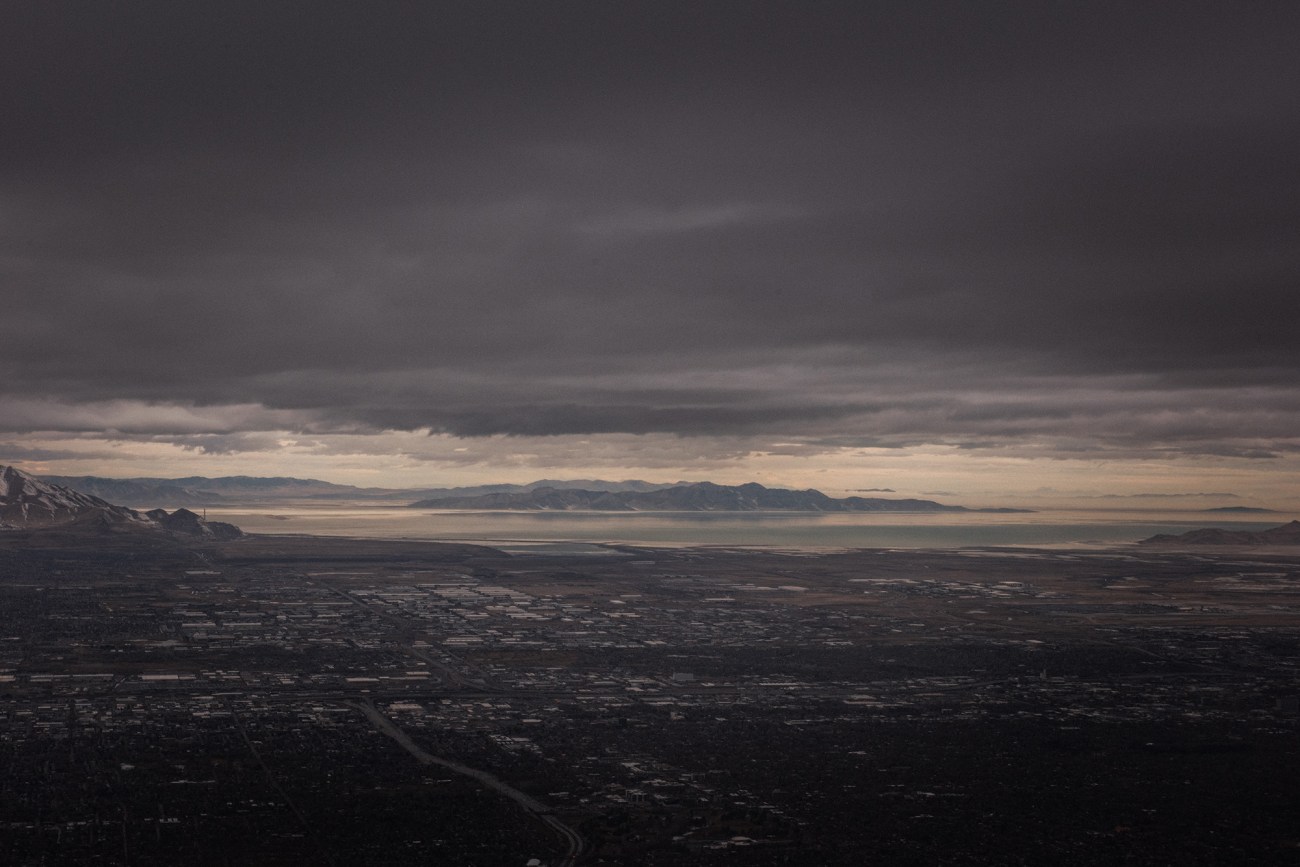
Stansbury Island on the Great Salt Lake and the edge of SLC from the Wasatch Range.
Despite Steed’s MAGA resume, Utah environmentalists are fans. As a white male Mormon, and “as a person who has worked in conservative governments, he might be just the right voice,” Baxter says. “I think it’s very important to have credibility with farmers, with the Mormon Church, with Republicans.” With Steed, she says, “you have someone who can speak that language.”
Indeed, Steed’s political savvy was on full display in the fall of 2021, when he testified at the state Capitol about the drought. At that same committee meeting, legislators spent most of their time bashing President Joe Biden’s efforts to combat climate change. They even showed a five-minute video from the right-wing PragerU media organization that claimed solar and wind power had more environmental impacts than burning coal. Yet Steed deftly addressed the water crisis, without triggering his audience by mentioning climate change, even though it was the subtext of everything he said.
In early 2022, he helped persuade the legislature to pass the kind of conservation measure they had long resisted, but one that can deliver big dividends: requiring meters on secondary water connections across the state and committing $250 million to the effort. In Utah, most water going to lawns and other outdoor uses has never been properly metered. “You can’t manage what you don’t measure,” Steed told me when I met him in Salt Lake City in August, saying the meters will ultimately conserve as much water as is currently stored in one of the state’s existing reservoirs.
During the worst of the drought in 2021, Governor Cox asked residents to pray for rain. This past winter, the Lord seems to have answered with a record snow dump that has raised the lake level enough that the brine flies have returned. “Great Salt Lake had a temporary reprieve because of this epic snowpack,” says Utah Rivers Council’s Frankel. “But it’s going to set a new record low next year, and it’s going to keep declining” unless elected officials act more decisively. “We’re still hopeful that we can still save the lake, that we can organize the public to have accountability of these failed leadership structures as represented by our current Republican leaders. But the race is on.”
Steed is optimistic. “I do think there’s something unique about Utah in our ability to rise to the occasion,” he said. “Not only can we [save the lake], but we have to. There is just too much at stake.”
